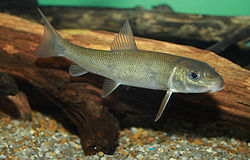| Catostomidae Temporal range: | |
|---|---|
 | |
| White sucker, Catostomus commersonii | |
| Scientific classification | |
| Kingdom: | Animalia |
| Phylum: | Chordata |
| Class: | Actinopterygii |
| Order: | Cypriniformes |
| Suborder: | Catostomoidei Betancur-R, et al., 2017 [1] |
| Family: | Catostomidae Agassiz, 1850 [2] |
| Genera | |
See text | |
The Catostomidae are the suckers of the order Cypriniformes, with about 78 species in this family of freshwater fishes. The Catostomidae are almost exclusively native to North America. The only exceptions are Catostomus catostomus, found in both North America and Russia, and Myxocyprinus asiaticus found only in China. In the Ozarks they are a common food fish and a festival is held each year to celebrate them. [3] The bigmouth buffalo, Ictiobus cyprinellus, can reach an age up to 127 years, [4] making it the oldest known freshwater teleost [5] by more than 50 years.



